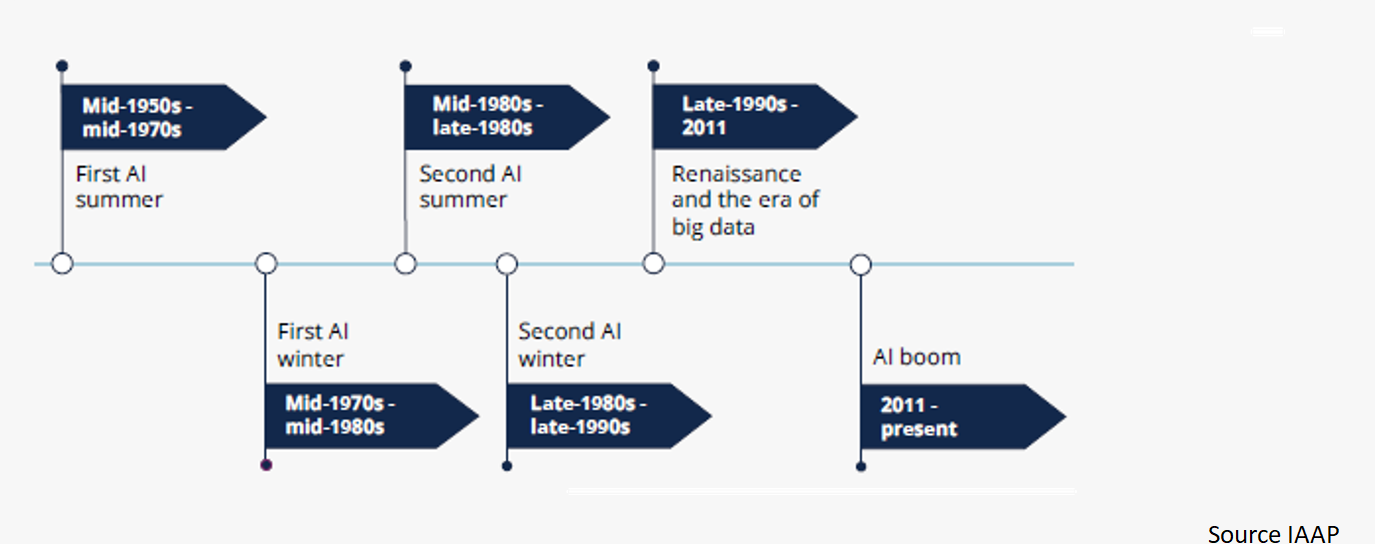In the past month, “AI bubble burst” media headlines have mostly been reacting to a sharp wobble in AI-linked stocks. But we have to ask, “Are we heading for an AI bubble and a burst?”
Firstly, we need to consider that AI is not new. The history of AI began with the early 20th-century concepts of thinking machines, but the field was officially born at the 1956 Dartmouth Workshop.
The following timeline shows that there has been 2 AI Winters, which is a period in the history of Artificial Intelligence was characterised by a decrease in funding, interest, and public excitement following periods of intense hype and unmet expectations.

Hence, better question is what kind of correction we should expect. History offers two useful mirrors: the late-1990s dot-com cycle and the 19th-century U.S. railroad build out. Both periods in history combined genuine technological breakthroughs with speculative excess. Both ended not with the end of the technology, but with a reshaping of who won, who lost, and how value was ultimately created. AI today looks like a fusion of these patterns: exuberant capital, breakneck infrastructure builds, and uneven yet very real utility.
During the dot-com era, the mantra was “eyeballs first, profits later.” Many businesses had users but lacked viable economics. The railroad boom featured promotional claims and proliferating charters that raced ahead of actual freight and passenger demand. AI’s current phase rhymes with both: valuations often price in world-changing impact now, while the operational benefits will arrive later as enterprises re-engineer processes, data, and governance. Periodic reality checks are inevitable, but that is not the same as a technology winter.
Dot-com excess produced “dark fibre”, vast bandwidth that sat unused until applications caught up. Railroads laid redundant, parallel lines that were eventually rationalised. AI’s equivalent is the compute and energy build out: Hyperscalers are spending at historic levels on data centres, GPUs, networking, and power. That investment is the “railway track” of the AI era. As with railways and fibre, a capex digestion phase is likely where capacity briefly outstrips demand before utilisation steadily rises.
After the dot-com crash, a handful of survivors including Amazon, Google, Microsoft, Oracle and others grew into the backbone of the web economy. Many railroads failed, merged, or were restructured, yet the network that remained powered a century of U.S. growth. Expect a similar AI trajectory, consolidation among model startups and thin moat applications, while durable platform infrastructure providers, foundation models with defensible moats, and integrators with distribution compound.
A common misconception in every tech boom is that utility must match valuation immediately. Benefits scale after standards, processes, and complementary assets mature. The internet’s productivity dividend became clear only once broadband, payments, logistics, and SaaS models matured. Railroads created outsized gains when standard gauge, timetables, and interchange agreements unlocked network effects. AI’s larger payoff will similarly follow standardised data pipelines, governance guardrails, and robust change management—the enterprise equivalent of agreeing on a “standard gauge.”
As the dot-com hardware stack commoditised, pricing power shifted to platforms and software ecosystems. Railroads saw freight rates compress as competition intensified; weaker lines failed. AI is poised for a comparable transition: as compute scarcity eases (more chip supply, better schedulers, open weights, inference optimisation), margin pressure will move upstream. Value will accrue to those turning usage into dependable revenue and measurable outcomes distribution, data advantages, and workflow embedding matter more than novelty.
The web economy only stabilised after clearer rules around privacy, payments, and competition created predictable playing fields. Railroads eventually faced the Interstate Commerce Commission and state rules that constrained abuses and accelerated consolidation. AI will be no different: safety regimes, auditability, data provenance requirements, and competitive oversight will raise the fixed costs of participation. That generally favours scaled, compliant operators and punishes under-capitalised or non-differentiated entrants.
The dot-com bust felt like a single dramatic collapse (2000–2002), yet the recovery was selective and prolonged. Railroads experienced waves of failures, mergers, and refinancing’s as conditions changed. AI is likely to experience rolling corrections rather than a single “big pop”, first in overheated niches (certain infrastructure suppliers or app layers with weak moats), followed by stabilisation as real deployments compound and customers demand tangibly better cost or revenue outcomes.
For Aotearoa New Zealand, the analogy is particularly instructive. Railroads and fibre were national enablers, yet the winners were those who paired infrastructure with locally relevant services, governance, and trust. AI is no different: organisations that align deployments with local data realities, cultural expectations, and sector specific outcomes will convert global infrastructure into domestic productivity. Conversely, those chasing hype without change management or data readiness will discover the limits of novelty.
AI in late 2025 resembles late-1999 dot-com meets 1870s railroads: speculative capital building something foundational. The right historical lesson isn’t “bubble, then bust, then nothing.” It’s overbuild, correction, consolidation then durable value as networks, standards, and complementary capabilities catch up. Expect froth to be skimmed and players to change, but the “tracks” being laid, compute, models, data pipelines, and governance are likely to carry the next decade of software and services. The aim now is to build for the post-digestion world: standardise the gauge, sweat the assets, and focus on real, repeatable outcomes.
ChatGPT Pro was used for research assistance. Google was used to fact check some items and terms for definitions.

